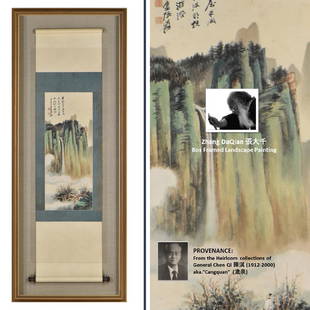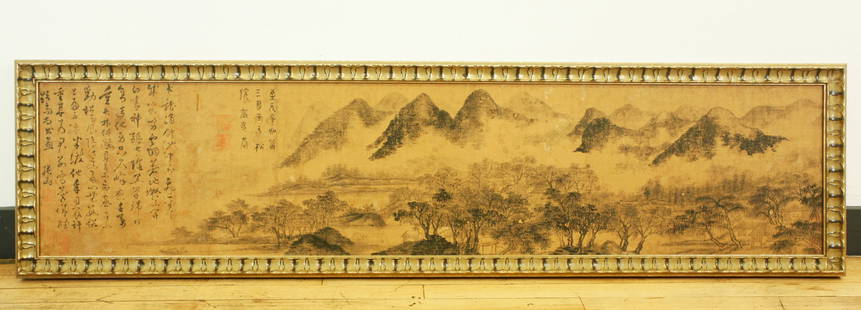
ZHANG DAQIAN, FRAMED LANDSCAPE PAINTING, CA. 1945
Zhang Daqian Sale History
View Price Results for Zhang DaqianRelated Scrolls, Screens & Fan Paintings
More Items from Zhang Daqian
View MoreRecommended Art
View More


















Item Details
Description
Zhang DaQian 張大千 (Chinese, 1899-1983) painted in Yi You year, 1945. A presented painting as gifts to General Chen CangQuan. Chinese ink and color scroll painting on paper. Hand painted in variegate tones and shades of waterside landscape. Rocks and trees, animated with fluttering texture strokes, dots, color washes, and daubs of bright mineral pigment, pulse with a calligraphic energy barely contained within the traditional landscape structure. Every characteristic feature of a country landscape is correspond to phases of the human soul; water regarded as the blood of the mountain, grass and trees their hair, mist and clouds their coloring; mountains to be the face of the waters, represents the spirit of his rustic surroundings. Painted with intense mineral colors and broad washes of layered ink, may represent Zhang's response to such influences, liberating effect of this painting mode on the master artist's creativity, which gave a spontaneity to the compositions. In spite of their abstract qualities, however, these paintings remained resolutely descriptive of the natural world. By first applied ink and color in a seemingly random manner, then added contour lines and other pictorial details in order to transform the composition into a highly suggestive vision of mist-engulfed mountains suddenly illuminated by a burst of sunlight that has turned the somber clouds iridescent. Themed caligraphy inscriptions to the upper left, dated and signed by artist, Zhang DaQian 張大千 , with three iron-red signature seals.
Mounted on creme silk, matted within grayish border, set behind glass and wooden box framed.
The portion of the sale will benefit a local church in Atlanta area.
Dimension: 77-1/2" H x 33" W
PROVENANCE:
From the collection of General Chen Qi 陳淇; (1912-2000), who styled himself as “Cangquan” (滄泉and “Yuquanshanren”玉泉山人), an artist, calligrapher, a prominent businessman and private antiques collector.
EDEN Fine Antiques Galleries is honored and proud to offer, once again, to be the last General Chen Qi's heirloom collections including unpublished painting from Zhang DaQian, Fu BaoShi, Qi BaiShi, Huang JunBi, Wu ChangShuo, Xu BeiHong, Dong ShouPing, Dong BangDa 董邦达, Li XiongCai, and many other famous artists; along with his extraordinary Chinese porcelain collections.
General Chen Qi's collections can be found on Lot-128 through Lot-161 (Day 1), continuing at Lot-402 through Lot-423 (Day 2).
For more information about General Chen Qi's Biography, please refer to provenance information at Lot 152.
http://chen-qi.net/
https://en.wikipedia.org/wiki/Chen_Qi_(collector)
LOT NOTES:
Zhang DaQian 張大千 (1899-1983), original name Zhang Yuan and pseudonym DaQian, was one of the best-known and most prodigious Chinese artists of the twentieth century. He is also regarded by many art experts as one of the most gifted master forgers of the twentieth century. He excelled at all types of paintings, and is especially famous for his landscape, as well as lotus paintings. As a child, Zhang DaQian was encouraged by his family to pursue painting.
In 1917 his elder brother, Zhang Shanzi (an artist famous for his tiger paintings), accompanied him to Kyoto, Japan, to study textile dyeing. Two years later, Zhang DaQian went to Shanghai to receive traditional painting instruction from two famous calligraphers and painters of the time, Zeng Xi and Li Ruiqing. Through his association with these teachers, Zhang had the opportunity to study some works by ancient masters in detail.
His early style attempted to emulate the Ming-Qing Individualists, including Tang Yin, Chen Hongshou , and Shitao. He meticulously studied and copied their works and began to make forgeries; his paintings after Shitao successfully deceived some of the best connoisseurs.
After his early success in Shanghai, Zhang extended his career to the north in the late 1920s, when he became active in the cultural circles of Beijing. He began to collaborate with the well-known Beijing painter Pu Xinyu, and together they became known as the South Zhang and North Pu, an epithet that is still used to refer to their collaborative works of the 1930s.
In 1940 Zhang DaQian led a group of artists to the caves of Mogao and Yulin. for the purpose of copying their Buddhist wall paintings. The group completed over 200 paintings, and the experience left Zhang with a repository of religious imagery. During the Sino-Japanese War, the artist zealously studied traditional Tang-Song figure painting and ancient monumental landscape painting. His love of tradition was also reflected in his personal collection of ancient Chinese paintings, which he began early in his career. At its peak, his collection contained several hundred works from the Tang to Qing dynasties.
In reaction to the political climate in 1949, Zhang left China in the early 1950s. He resided in various places, including Mendoza, Argentina; Sao Paulo, Brazil; and Carmel, California. His meeting with Pablo Picasso in 1956 in Nice, France, was publicized as an artistic meeting between East and West. Hang DaQian developed eye problems in the late 1950s. As his eyesight deteriorated, he developed his mature splashed color (pocai) style. Although he attributed this style in part to the splashed-ink technique of the ancient painter Wang Mo (also known as Wang Qia , many believe it to be related to that of the Abstract Expressionist movement then popular in the United States and a departure from that of his traditional paintings.
Zhang's splashed-color paintings fetched the highest market prices for contemporary Chinese paintings at international auctions of the time. In 1978 the artist settled in Taipei, Taiwan. His residence, Moye Jingshe, next to the National Palace Museum, is now the Memorial Museum of Zhang DaQian.
Mounted on creme silk, matted within grayish border, set behind glass and wooden box framed.
The portion of the sale will benefit a local church in Atlanta area.
Dimension: 77-1/2" H x 33" W
PROVENANCE:
From the collection of General Chen Qi 陳淇; (1912-2000), who styled himself as “Cangquan” (滄泉and “Yuquanshanren”玉泉山人), an artist, calligrapher, a prominent businessman and private antiques collector.
EDEN Fine Antiques Galleries is honored and proud to offer, once again, to be the last General Chen Qi's heirloom collections including unpublished painting from Zhang DaQian, Fu BaoShi, Qi BaiShi, Huang JunBi, Wu ChangShuo, Xu BeiHong, Dong ShouPing, Dong BangDa 董邦达, Li XiongCai, and many other famous artists; along with his extraordinary Chinese porcelain collections.
General Chen Qi's collections can be found on Lot-128 through Lot-161 (Day 1), continuing at Lot-402 through Lot-423 (Day 2).
For more information about General Chen Qi's Biography, please refer to provenance information at Lot 152.
http://chen-qi.net/
https://en.wikipedia.org/wiki/Chen_Qi_(collector)
LOT NOTES:
Zhang DaQian 張大千 (1899-1983), original name Zhang Yuan and pseudonym DaQian, was one of the best-known and most prodigious Chinese artists of the twentieth century. He is also regarded by many art experts as one of the most gifted master forgers of the twentieth century. He excelled at all types of paintings, and is especially famous for his landscape, as well as lotus paintings. As a child, Zhang DaQian was encouraged by his family to pursue painting.
In 1917 his elder brother, Zhang Shanzi (an artist famous for his tiger paintings), accompanied him to Kyoto, Japan, to study textile dyeing. Two years later, Zhang DaQian went to Shanghai to receive traditional painting instruction from two famous calligraphers and painters of the time, Zeng Xi and Li Ruiqing. Through his association with these teachers, Zhang had the opportunity to study some works by ancient masters in detail.
His early style attempted to emulate the Ming-Qing Individualists, including Tang Yin, Chen Hongshou , and Shitao. He meticulously studied and copied their works and began to make forgeries; his paintings after Shitao successfully deceived some of the best connoisseurs.
After his early success in Shanghai, Zhang extended his career to the north in the late 1920s, when he became active in the cultural circles of Beijing. He began to collaborate with the well-known Beijing painter Pu Xinyu, and together they became known as the South Zhang and North Pu, an epithet that is still used to refer to their collaborative works of the 1930s.
In 1940 Zhang DaQian led a group of artists to the caves of Mogao and Yulin. for the purpose of copying their Buddhist wall paintings. The group completed over 200 paintings, and the experience left Zhang with a repository of religious imagery. During the Sino-Japanese War, the artist zealously studied traditional Tang-Song figure painting and ancient monumental landscape painting. His love of tradition was also reflected in his personal collection of ancient Chinese paintings, which he began early in his career. At its peak, his collection contained several hundred works from the Tang to Qing dynasties.
In reaction to the political climate in 1949, Zhang left China in the early 1950s. He resided in various places, including Mendoza, Argentina; Sao Paulo, Brazil; and Carmel, California. His meeting with Pablo Picasso in 1956 in Nice, France, was publicized as an artistic meeting between East and West. Hang DaQian developed eye problems in the late 1950s. As his eyesight deteriorated, he developed his mature splashed color (pocai) style. Although he attributed this style in part to the splashed-ink technique of the ancient painter Wang Mo (also known as Wang Qia , many believe it to be related to that of the Abstract Expressionist movement then popular in the United States and a departure from that of his traditional paintings.
Zhang's splashed-color paintings fetched the highest market prices for contemporary Chinese paintings at international auctions of the time. In 1978 the artist settled in Taipei, Taiwan. His residence, Moye Jingshe, next to the National Palace Museum, is now the Memorial Museum of Zhang DaQian.
Condition
Over all in EXCELLENT Condition. Natural imperfection on the medium (paper or silk), regardless from any major damages; includes light blooms, discoloration and minor fading. Consider normal due to the ages.
The bidder assumes responsibility for ensuring that the condition of the item(s) meets with their satisfaction prior to bidding. Any condition statement is given as a courtesy to a client, and is only an opinion and should not be treated as a statement of fact. EDEN Galleries shall have no responsibility for any error or omission. The absence of a condition statement does not imply that the lot is in perfect condition or completely free from wear and tear, imperfections or the effects of aging.
The bidder assumes responsibility for ensuring that the condition of the item(s) meets with their satisfaction prior to bidding. Any condition statement is given as a courtesy to a client, and is only an opinion and should not be treated as a statement of fact. EDEN Galleries shall have no responsibility for any error or omission. The absence of a condition statement does not imply that the lot is in perfect condition or completely free from wear and tear, imperfections or the effects of aging.
Buyer's Premium
- 25% up to $100,000.00
- 20% up to $1,000,000.00
- 15% above $1,000,000.00
ZHANG DAQIAN, FRAMED LANDSCAPE PAINTING, CA. 1945
Estimate $3,000 - $5,000
22 bidders are watching this item.
Get approved to bid.
Shipping & Pickup Options
Item located in Marietta, GA, usSee Policy for Shipping
Payment
Accepts seamless payments through LiveAuctioneers

Related Searches
TOP














































![[Authentic work] Yoshiko Shindo/Abstract painting/Still life painting/Oil painting/Contemporary art/: Yukichi Fukuzawa Fleshy Painting Authentic Oil Painting Painting Figure Painting Type of painting...Watercolor Painting Format...Framed Subject...Landscape/Seascape Main painting material...Acrylic pa](https://p1.liveauctioneers.com/8563/327189/176450448_1_x.jpg?height=310&quality=70&version=1714042067)
































